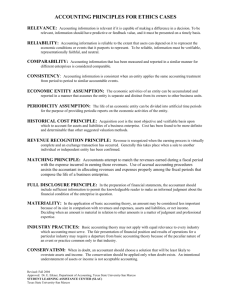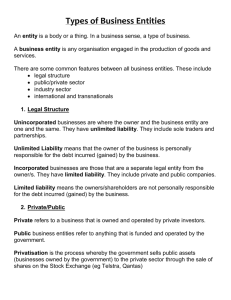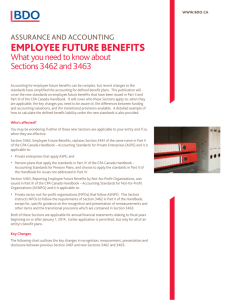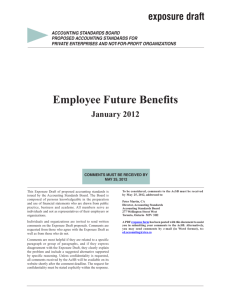ASPE at a Glance - Section 3462: Employee Future Benefits
advertisement
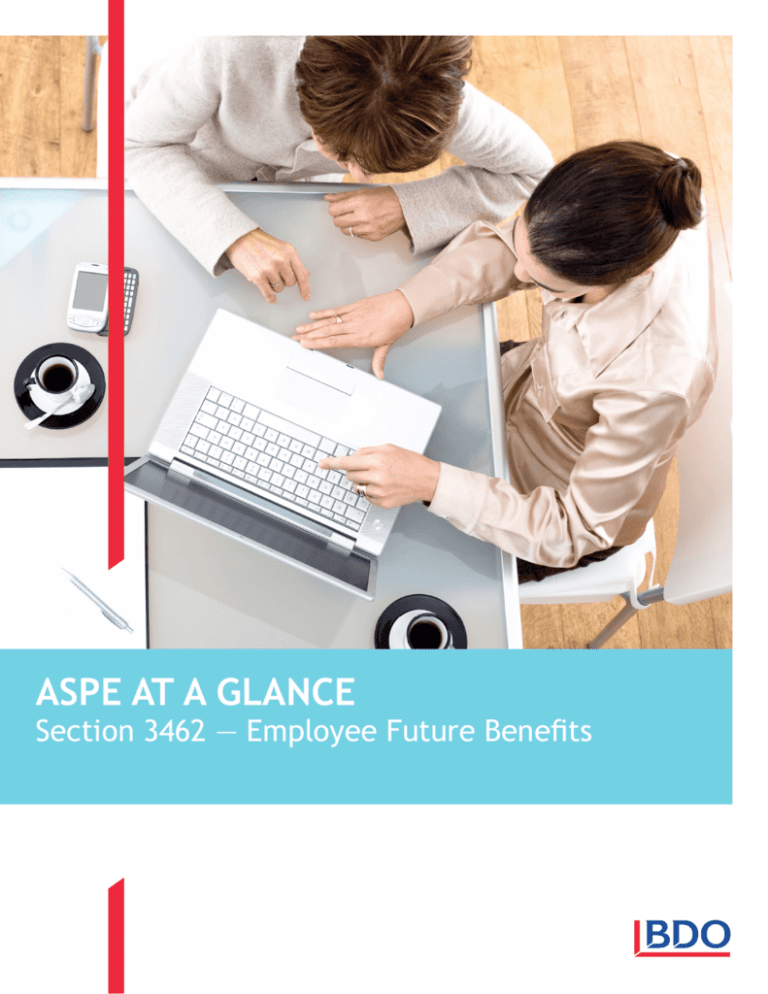
ASPE AT A GLANCE Section 3462 — Employee Future Benefits November 2015 Section 3462 – Employee Future Benefits Effective Date Fiscal years beginning on or after January 1, 20141 SCOPE Applies to: Employee future benefits include the following: Pension and other retirement benefits that an entity anticipates providing to employees and their beneficiaries after retirement. Post-employment benefits that an entity anticipates providing to employees and their beneficiaries subsequent to employment but prior to retirement. Compensated absences that an entity anticipates paying to employees. Termination benefits. Any arrangement that is a benefit plan in substance irrespective of its form or the method / timing of its funding. Future benefits that an entity pays all / part of the cost. Entities with funded or unfunded benefit plans. BASIC PRINCIPLES Does not apply to: Benefits an entity provides to employees during active employment. The objective of accounting for employee future benefits is to recognize a liability and a cost during the reporting period when an employee provides the service that results in the future benefits. Defined contribution plans and defined benefit plans When an entity provides benefits under a defined benefit plan it bears the following risks: Actuarial risk - the risk regarding the amount of benefits each employee will actually receive. Investment risk – the risk investment returns on assets set aside to pay for the cost of the employee benefits will fall short and the entity will be responsible for funding the difference. Conversely, when an entity provides benefits under a defined contribution plan it does not bear the actuarial or investment risks, instead it is the employees who bear these risks. The economic substance of the plan determines it’s classification as either a defined benefit plan or a defined contribution plan. DEFINED CONTRIBUTION PLANS A benefit plan that specifies how an entity’s contributions to the plan are determined instead of specifying the benefits an employee will receive or the method of determining those benefits. The cost for a period that an entity recognizes includes: The current service cost; The past service cost; The interest cost on the estimated present value of any contributions required in future periods that results from employee services provided during the current / prior periods; and A reduction for interest income on any unallocated plan surplus. The cost for the period is either expensed or capitalized as part of an asset such as inventory or property, plant and equipment. DEFINED BENEFIT PLANS A benefit plan that is not a defined contribution plan. Defined benefit liability (asset) The amount of the defined benefit obligation less the fair value of plan assets, if any, adjusted for any valuation allowance in the case of a net asset. Recognition An entity must recognize: The defined benefit liability (asset) in the balance sheet at the end of the period; and The costs of the plan for the period, which would include remeasurements, (refer to paragraphs 3462.076-.090) as either: An expense; or An amount capitalized as part of an asset such as inventory or property, plant and equipment. The defined benefit obligation and the cost for employee future benefits must be recognized in the same period when the employees provide services to the entity in exchange for the benefits, except for postemployment benefits and compensated absences that do not vest or accumulate. In this case, the entity must recognize the defined benefit obligation and the cost for employee future benefits at the time the event that obligates the entity occurs. 1 Except as specified in paragraph 3462.119. Earlier application is permitted, but only if applied to all of an entity’s benefit plans. This Section is applied retrospectively, in accordance with Section 1506, Accounting Changes, except as set out in paragraphs 3462.121-.124. DEFINED BENEFIT PLANS (CONTINUED) Measurement of a defined benefit obligation An entity must measure the defined benefit obligation for each of its defined benefit plans as of the balance sheet date using either: An actuarial valuation prepared for accounting purposes as set out in paragraphs 3462.035-.061; or An actuarial valuation prepared for funding purposes, provided the criteria in paragraphs 3462.029B or 3462.029C, and paragraph 3462.029D are met. TERMINATION BENEFITS When special termination benefits are offered to employees for voluntary termination and the employees accept the offer and a reasonable estimate can be made of the amount of the benefits an entity must recognize: A liability; and An expense. When special termination benefits are offered to employees for involuntary termination a liability and expense must be recognized by the entity in the period when: A plan of termination has been approved and committed to by management with the proper authority and this plan sets out the benefits employees will receive on termination; Communication has been provided to employees in enough detail to allow them to understand the type and amount of benefits to be received on termination. The intended reduction in the number of employees, job classifications / functions and locations are all identified by the termination plan; and The termination plan indicates significant changes to the plan are unlikely during the time required to complete the plan. When contractual termination benefits must be provided to employees under the existing terms of a benefit plan, an entity must recognize a liability and expense when: It is probable the employees will be entitled to benefits; and A reasonable estimate can be made of the amount. MULTIEMPLOYER AND MULTIPLE-EMPLOYER BENEFIT PLANS MULTIEMPLOYER PLAN A defined benefit plan to which two or more unrelated entities contribute, normally pursuant to one or more collective bargaining agreements. An entity may apply defined contribution accounting when sufficient information is not available to apply the accounting requirements for defined benefit plans. MULTIPLE-EMPLOYER BENEFIT PLAN A defined benefit plan maintained by more than one entity that is not a multiemployer plan. Each entity in a multiple-employer plan accounts for their plan using defined benefit accounting as set out in this Section and accounts for its plan assets based on its proportionate interest in the assets of the multiple-employer plan. National Office 36 Toronto Street Suite 600 Toronto ON M5C 2C5 800 805 9544 www.bdo.ca This publication has been carefully prepared, but it has been written in general terms and should be seen as broad guidance only. The publication cannot be relied upon to cover specific situations and you should not act, or refrain from acting, upon the information contained therein without obtaining specific professional advice. Please contact BDO Canada LLP to discuss these matters in the context of your particular circumstances. BDO Canada LLP, its partners, employees and agents do not accept or assume any liability or duty of care for any loss arising from any action taken or not taken by anyone in reliance on the information in this publication or for any decision based on it. BDO Canada LLP, a Canadian limited liability partnership, is a member of BDO International Limited, a UK company limited by guarantee, and forms part of the international BDO network of independent member firms. BDO is the brand name for the BDO network and for each of the BDO Member Firms.




